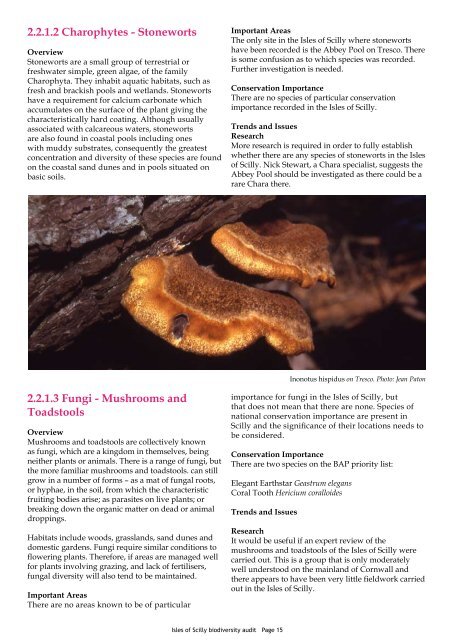The Isles of Scilly Biodiversity Audit 2008 - Cornwall Wildlife Trust
The Isles of Scilly Biodiversity Audit 2008 - Cornwall Wildlife Trust
The Isles of Scilly Biodiversity Audit 2008 - Cornwall Wildlife Trust
You also want an ePaper? Increase the reach of your titles
YUMPU automatically turns print PDFs into web optimized ePapers that Google loves.
2.2.1.2 Charophytes - StonewortsOverviewStoneworts are a small group <strong>of</strong> terrestrial orfreshwater simple, green algae, <strong>of</strong> the familyCharophyta. <strong>The</strong>y inhabit aquatic habitats, such asfresh and brackish pools and wetlands. Stonewortshave a requirement for calcium carbonate whichaccumulates on the surface <strong>of</strong> the plant giving thecharacteristically hard coating. Although usuallyassociated with calcareous waters, stonewortsare also found in coastal pools including oneswith muddy substrates, consequently the greatestconcentration and diversity <strong>of</strong> these species are foundon the coastal sand dunes and in pools situated onbasic soils.Important Areas<strong>The</strong> only site in the <strong>Isles</strong> <strong>of</strong> <strong>Scilly</strong> where stonewortshave been recorded is the Abbey Pool on Tresco. <strong>The</strong>reis some confusion as to which species was recorded.Further investigation is needed.Conservation Importance<strong>The</strong>re are no species <strong>of</strong> particular conservationimportance recorded in the <strong>Isles</strong> <strong>of</strong> <strong>Scilly</strong>.Trends and IssuesResearchMore research is required in order to fully establishwhether there are any species <strong>of</strong> stoneworts in the <strong>Isles</strong><strong>of</strong> <strong>Scilly</strong>. Nick Stewart, a Chara specialist, suggests theAbbey Pool should be investigated as there could be arare Chara there.Inonotus hispidus on Tresco. Photo: Jean Paton2.2.1.3 Fungi - Mushrooms andToadstoolsOverviewMushrooms and toadstools are collectively knownas fungi, which are a kingdom in themselves, beingneither plants or animals. <strong>The</strong>re is a range <strong>of</strong> fungi, butthe more familiar mushrooms and toadstools. can stillgrow in a number <strong>of</strong> forms – as a mat <strong>of</strong> fungal roots,or hyphae, in the soil, from which the characteristicfruiting bodies arise; as parasites on live plants; orbreaking down the organic matter on dead or animaldroppings.Habitats include woods, grasslands, sand dunes anddomestic gardens. Fungi require similar conditions t<strong>of</strong>lowering plants. <strong>The</strong>refore, if areas are managed wellfor plants involving grazing, and lack <strong>of</strong> fertilisers,fungal diversity will also tend to be maintained.Important Areas<strong>The</strong>re are no areas known to be <strong>of</strong> particularimportance for fungi in the <strong>Isles</strong> <strong>of</strong> <strong>Scilly</strong>, butthat does not mean that there are none. Species <strong>of</strong>national conservation importance are present in<strong>Scilly</strong> and the significance <strong>of</strong> their locations needs tobe considered.Conservation Importance<strong>The</strong>re are two species on the BAP priority list:Elegant Earthstar Geastrum elegansCoral Tooth Hericium coralloidesTrends and IssuesResearchIt would be useful if an expert review <strong>of</strong> themushrooms and toadstools <strong>of</strong> the <strong>Isles</strong> <strong>of</strong> <strong>Scilly</strong> werecarried out. This is a group that is only moderatelywell understood on the mainland <strong>of</strong> <strong>Cornwall</strong> andthere appears to have been very little fieldwork carriedout in the <strong>Isles</strong> <strong>of</strong> <strong>Scilly</strong>.<strong>Isles</strong> <strong>of</strong> <strong>Scilly</strong> biodiversity audit Page 15
















